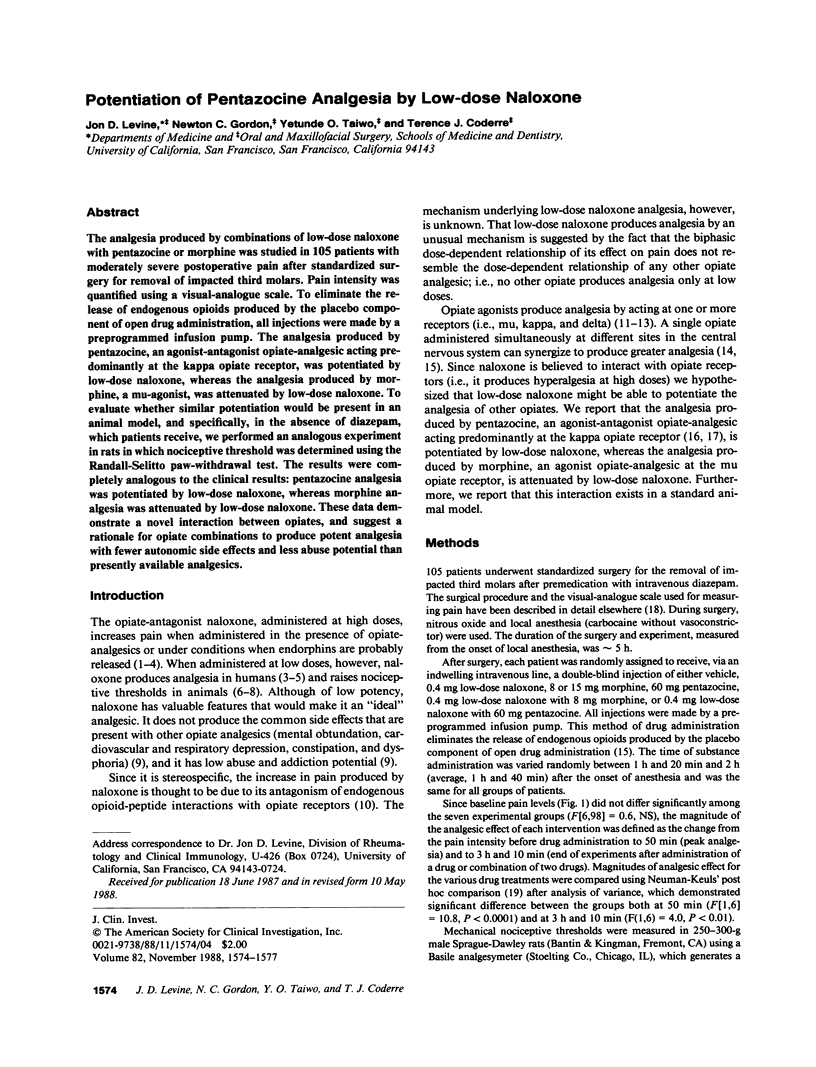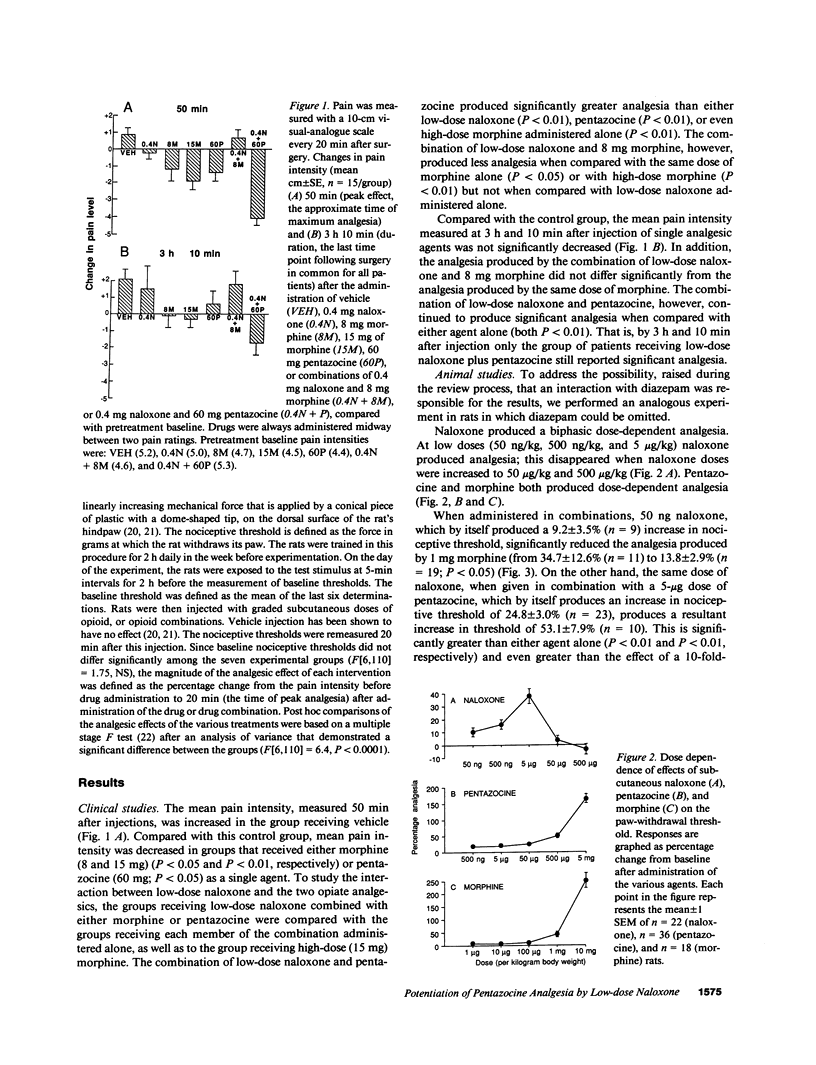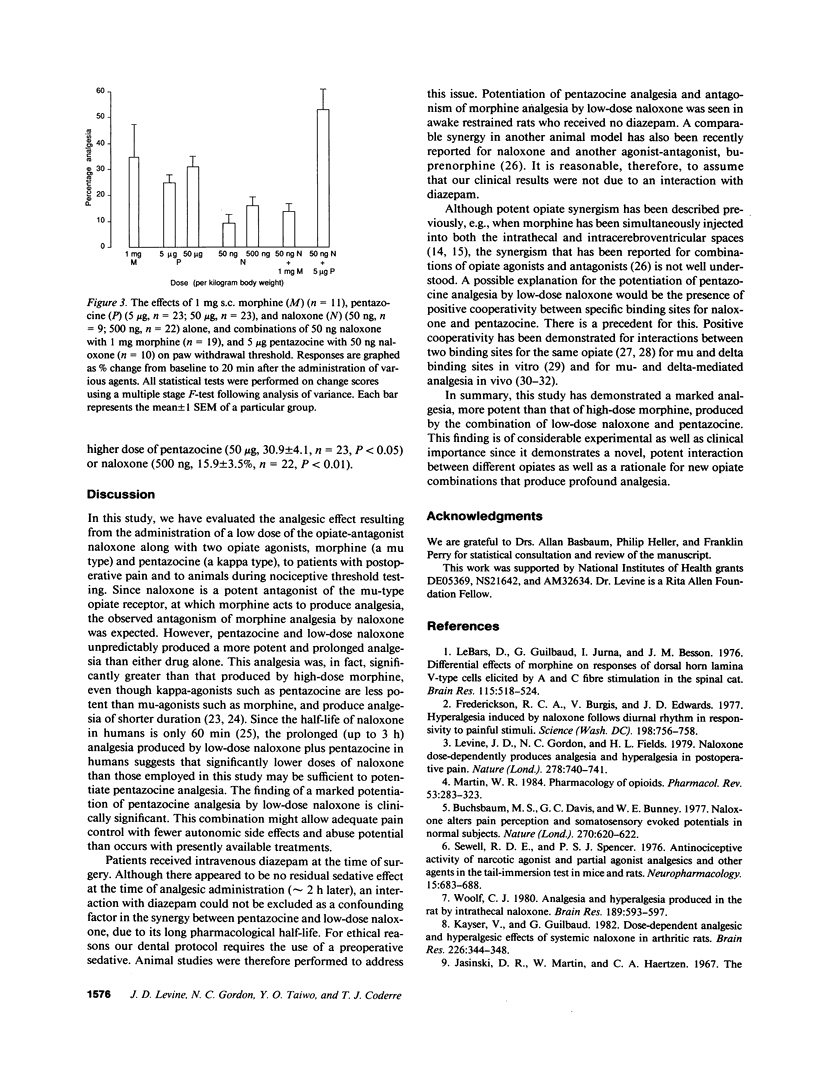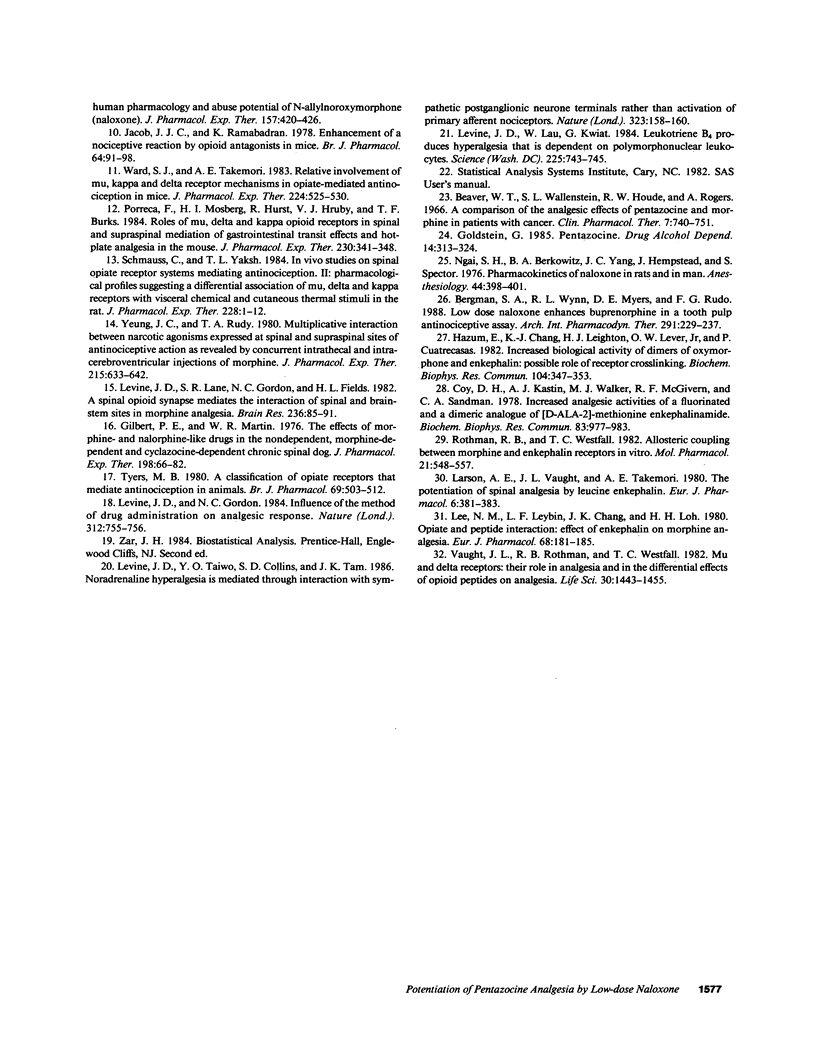Abstract
The analgesia produced by combinations of low-dose naloxone with pentazocine or morphine was studied in 105 patients with moderately severe postoperative pain after standardized surgery for removal of impacted third molars. Pain intensity was quantified using a visual-analogue scale. To eliminate the release of endogenous opioids produced by the placebo component of open drug administration, all injections were made by a preprogrammed infusion pump. The analgesia produced by pentazocine, an agonist-antagonist opiate-analgesic acting predominantly at the kappa opiate receptor, was potentiated by low-dose naloxone, whereas the analgesia produced by morphine, a mu-agonist, was attenuated by low-dose naloxone. To evaluate whether similar potentiation would be present in an animal model, and specifically, in the absence of diazepam, which patients receive, we performed an analogous experiment in rats in which nociceptive threshold was determined using the Randall-Selitto paw-withdrawal test. The results were completely analogous to the clinical results: pentazocine analgesia was potentiated by low-dose naloxone, whereas morphine analgesia was attenuated by low-dose naloxone. These data demonstrate a novel interaction between opiates, and suggest a rationale for opiate combinations to produce potent analgesia with fewer autonomic side effects and less abuse potential than presently available analgesics.
Full text
PDF



Selected References
These references are in PubMed. This may not be the complete list of references from this article.
- Beaver W. T., Wallenstein S. L., Houde R. W., Rogers A. A comparison of the analgesic effects of pentazocine and morphine in patients with cancer. Clin Pharmacol Ther. 1966 Nov-Dec;7(6):740–751. doi: 10.1002/cpt196676740. [DOI] [PubMed] [Google Scholar]
- Bergman S. A., Wynn R. L., Myers D. E., Rudo F. G. Low dose naloxone enhances buprenorphine in a tooth pulp antinociceptive assay. Arch Int Pharmacodyn Ther. 1988 Jan-Feb;291:229–237. [PubMed] [Google Scholar]
- Buchsbaum M. S., Davis G. C., Bunney W. E., Jr Naloxone alters pain perception and somatosensory evoked potentials in normal subjects. Nature. 1977 Dec 15;270(5638):620–622. doi: 10.1038/270620a0. [DOI] [PubMed] [Google Scholar]
- Coy D. H., Kastin A. J., Walker M. J., McGivern R. F., Sandman C. A. Increased analgesic activities of a fluorinated and a dimeric analogue of [D-Ala-2]-methionine enkephalinamide. Biochem Biophys Res Commun. 1978 Aug 14;83(3):977–983. doi: 10.1016/0006-291x(78)91491-2. [DOI] [PubMed] [Google Scholar]
- Frederickson R. C., Burgis V., Edwards J. D. Hyperalgesia induced by naloxone follows diurnal rhythm in responsivity to painful stimuli. Science. 1977 Nov 18;198(4318):756–758. doi: 10.1126/science.561998. [DOI] [PubMed] [Google Scholar]
- Gilbert P. E., Martin W. R. The effects of morphine and nalorphine-like drugs in the nondependent, morphine-dependent and cyclazocine-dependent chronic spinal dog. J Pharmacol Exp Ther. 1976 Jul;198(1):66–82. [PubMed] [Google Scholar]
- Goldstein G. Pentazocine. Drug Alcohol Depend. 1985 Feb;14(3-4):313–323. doi: 10.1016/0376-8716(85)90064-x. [DOI] [PubMed] [Google Scholar]
- Hazum E., Chang K. J., Leighton H. J., Lever O. W., Jr, Cuatrecasas P. Increased biological activity of dimers of oxymorphone and enkephalin: possible role of receptor crosslinking. Biochem Biophys Res Commun. 1982 Jan 15;104(1):347–353. doi: 10.1016/0006-291x(82)91981-7. [DOI] [PubMed] [Google Scholar]
- Jacob J. J., Ramabadran K. Enhancement of a nociceptive reaction by opioid antagonists in mice. Br J Pharmacol. 1978 Sep;64(1):91–98. doi: 10.1111/j.1476-5381.1978.tb08645.x. [DOI] [PMC free article] [PubMed] [Google Scholar]
- Jasinski D. R., Martin W. R., Haertzen C. A. The human pharmacology and abuse potential of N-allylnoroxymorphone (naloxone). J Pharmacol Exp Ther. 1967 Aug;157(2):420–426. [PubMed] [Google Scholar]
- Kayser V., Guilbaud G. Dose-dependent analgesic and hyperalgesic effects of systemic naloxone in arthritic rats. Brain Res. 1981 Dec 7;226(1-2):344–348. doi: 10.1016/0006-8993(81)91110-0. [DOI] [PubMed] [Google Scholar]
- Larson A. A., Vaught J. L., Takemori A. E. The potentiation of spinal analgesia by leucine enkephalin. Eur J Pharmacol. 1980 Feb;61(4):381–383. doi: 10.1016/0014-2999(80)90077-1. [DOI] [PubMed] [Google Scholar]
- Le Bars D., Guilbaud G., Jurna I., Besson J. M. Differential effects of morphine on responses of dorsal horn lamina V type cells elicited by A and C fibre stimulation in the spinal cat. Brain Res. 1976 Oct 22;115(3):518–524. doi: 10.1016/0006-8993(76)90370-x. [DOI] [PubMed] [Google Scholar]
- Lee N. M., Leybin L., Chang J. K., Loh H. H. Opiate and peptide interaction: effect of enkephalins on morphine analgesia. Eur J Pharmacol. 1980 Nov 21;68(2):181–185. doi: 10.1016/0014-2999(80)90319-2. [DOI] [PubMed] [Google Scholar]
- Levine J. D., Gordon N. C., Fields H. L. Naloxone dose dependently produces analgesia and hyperalgesia in postoperative pain. Nature. 1979 Apr 19;278(5706):740–741. doi: 10.1038/278740a0. [DOI] [PubMed] [Google Scholar]
- Levine J. D., Gordon N. C. Influence of the method of drug administration on analgesic response. Nature. 1984 Dec 20;312(5996):755–756. doi: 10.1038/312755a0. [DOI] [PubMed] [Google Scholar]
- Levine J. D., Lane S. R., Gordon N. C., Fields H. L. A spinal opioid synapse mediates the interaction of spinal and brain stem sites in morphine analgesia. Brain Res. 1982 Mar 18;236(1):85–91. doi: 10.1016/0006-8993(82)90036-1. [DOI] [PubMed] [Google Scholar]
- Levine J. D., Lau W., Kwiat G., Goetzl E. J. Leukotriene B4 produces hyperalgesia that is dependent on polymorphonuclear leukocytes. Science. 1984 Aug 17;225(4663):743–745. doi: 10.1126/science.6087456. [DOI] [PubMed] [Google Scholar]
- Levine J. D., Taiwo Y. O., Collins S. D., Tam J. K. Noradrenaline hyperalgesia is mediated through interaction with sympathetic postganglionic neurone terminals rather than activation of primary afferent nociceptors. Nature. 1986 Sep 11;323(6084):158–160. doi: 10.1038/323158a0. [DOI] [PubMed] [Google Scholar]
- Ngai S. H., Berkowitz B. A., Yang J. C., Hempstead J., Spector S. Pharmacokinetics of naloxone in rats and in man: basis for its potency and short duration of action. Anesthesiology. 1976 May;44(5):398–401. doi: 10.1097/00000542-197605000-00008. [DOI] [PubMed] [Google Scholar]
- Porreca F., Mosberg H. I., Hurst R., Hruby V. J., Burks T. F. Roles of mu, delta and kappa opioid receptors in spinal and supraspinal mediation of gastrointestinal transit effects and hot-plate analgesia in the mouse. J Pharmacol Exp Ther. 1984 Aug;230(2):341–348. [PubMed] [Google Scholar]
- Rothman R. B., Westfall T. C. Allosteric coupling between morphine and enkephalin receptors in vitro. Mol Pharmacol. 1982 May;21(3):548–557. [PubMed] [Google Scholar]
- Schmauss C., Yaksh T. L. In vivo studies on spinal opiate receptor systems mediating antinociception. II. Pharmacological profiles suggesting a differential association of mu, delta and kappa receptors with visceral chemical and cutaneous thermal stimuli in the rat. J Pharmacol Exp Ther. 1984 Jan;228(1):1–12. [PubMed] [Google Scholar]
- Sewell R. D., Spencer P. S. Antinociceptive activitiy of narcotic agonist and partial agonist analgesics and other agents in the tail-immersion test in mice and rats. Neuropharmacology. 1976 Nov;15(11):683–688. doi: 10.1016/0028-3908(76)90037-x. [DOI] [PubMed] [Google Scholar]
- Tyers M. B. A classification of opiate receptors that mediate antinociception in animals. Br J Pharmacol. 1980 Jul;69(3):503–512. doi: 10.1111/j.1476-5381.1980.tb07041.x. [DOI] [PMC free article] [PubMed] [Google Scholar]
- Vaught J. L., Rothman R. B., Westfall T. C. Mu and delta receptors: their role in analgesia in the differential effects of opioid peptides on analgesia. Life Sci. 1982 Apr 26;30(17):1443–1455. doi: 10.1016/0024-3205(82)90558-6. [DOI] [PubMed] [Google Scholar]
- Ward S. J., Takemori A. E. Relative involvement of mu, kappa and delta receptor mechanisms in opiate-mediated antinociception in mice. J Pharmacol Exp Ther. 1983 Mar;224(3):525–530. [PubMed] [Google Scholar]
- Woolf C. J. Analgesia and hyperalgesia produced in the rat by intrathecal naloxone. Brain Res. 1980 May 12;189(2):593–597. doi: 10.1016/0006-8993(80)90375-3. [DOI] [PubMed] [Google Scholar]
- Yeung J. C., Rudy T. A. Multiplicative interaction between narcotic agonisms expressed at spinal and supraspinal sites of antinociceptive action as revealed by concurrent intrathecal and intracerebroventricular injections of morphine. J Pharmacol Exp Ther. 1980 Dec;215(3):633–642. [PubMed] [Google Scholar]


